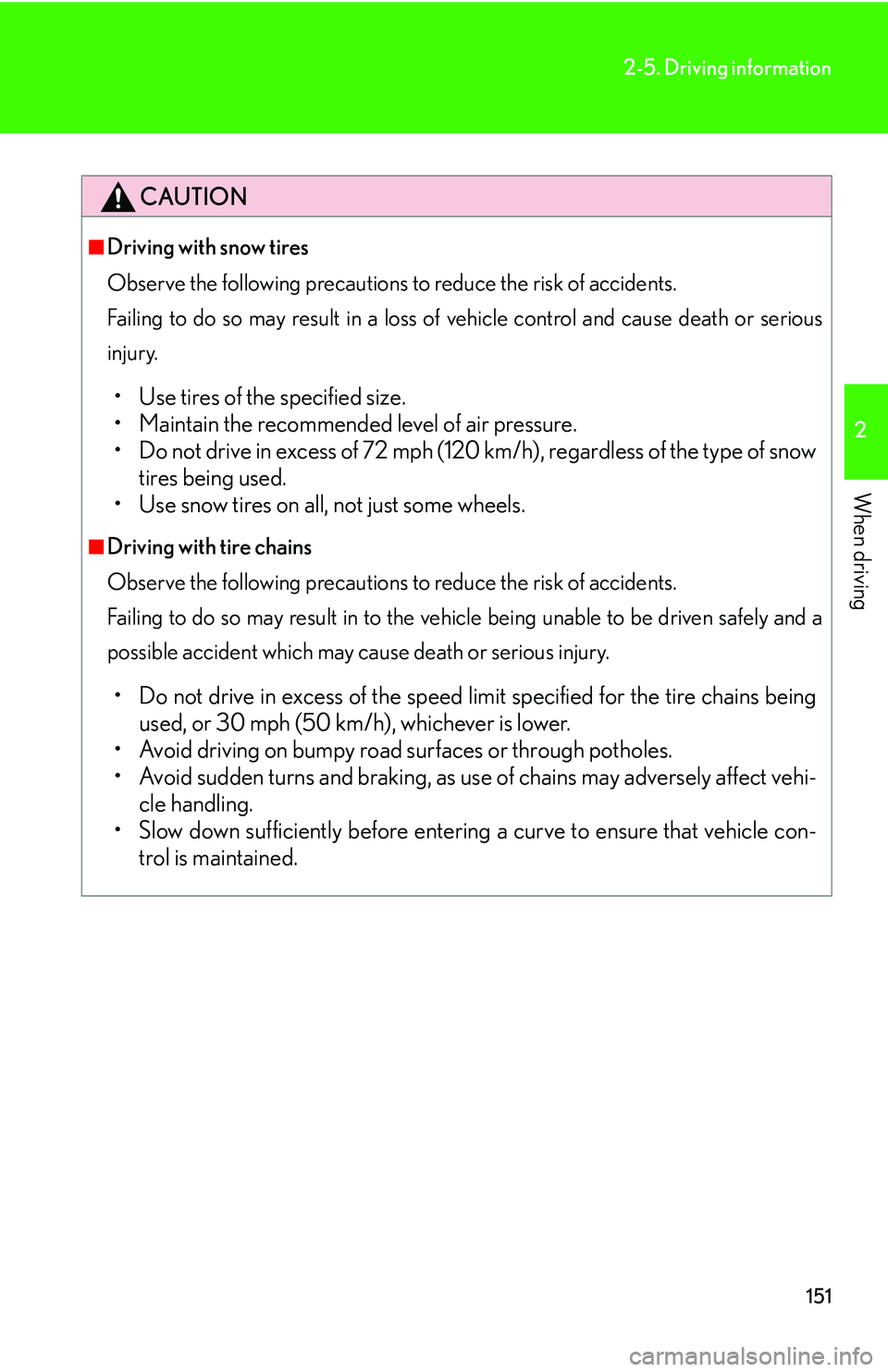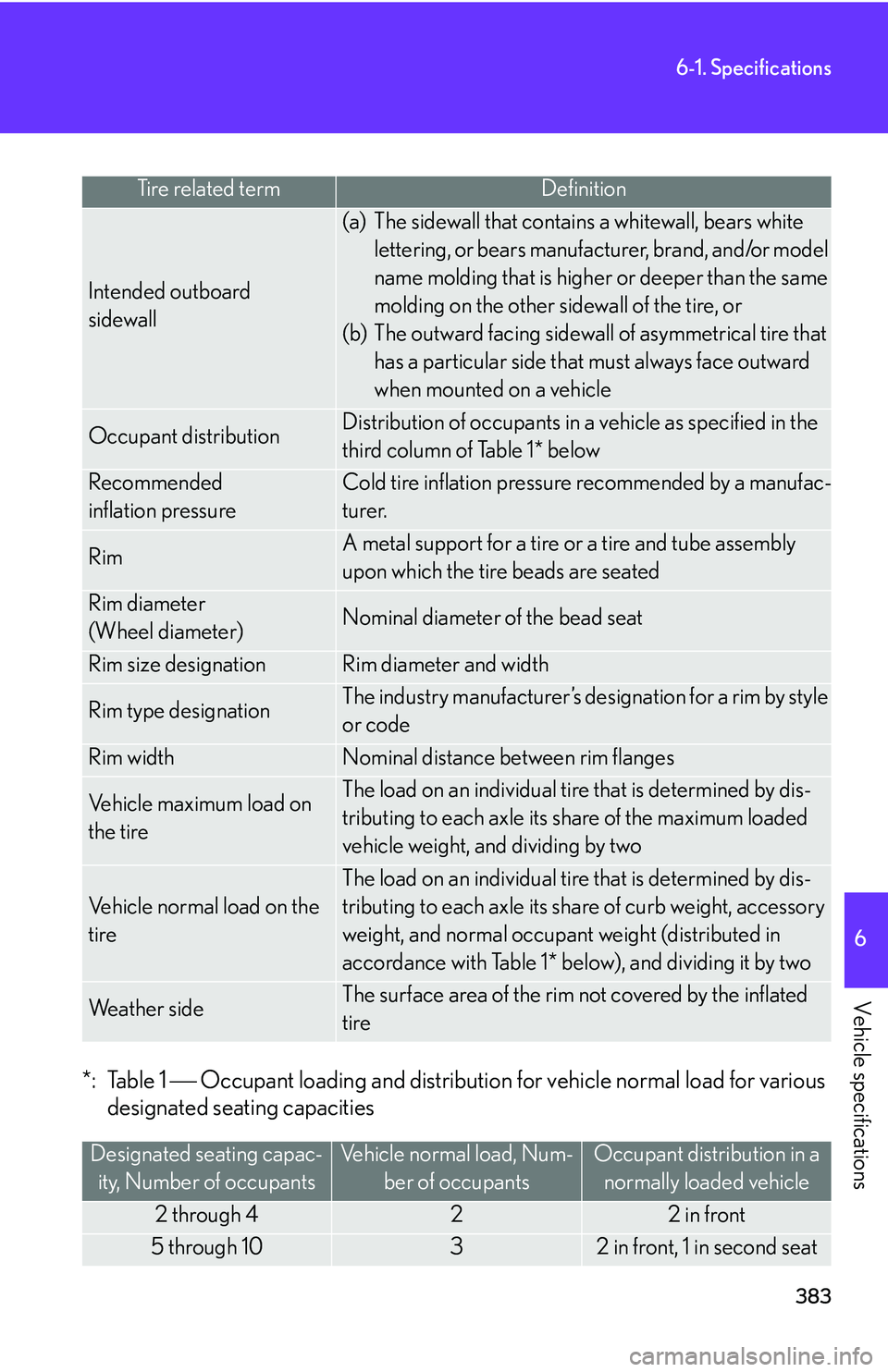Page 166 of 419

150
2-5. Driving information
Regulations on the use of snow chains
●Regulations regarding the use of tire chains vary according to location
and type of road. Alwa ys check local regulations before installing
chains.
●Use SAE Class “S” type radial tire chains, with the exception of radial
cable chains or V-bar type chains.
• Install the chains on the rear tires.
• Refer to the explanation that comes with the tir
e chains for installa-
tion instructions.
●Retighten chains after driving 1 /4 - 1 /2 mile (0.5 - 1.0 km).
■If the chains are installed
The tire pressure warning system may not operate properly.
■Tire chain installation
Observe the following installation, removal and care precautions.
• Install and remove tire chains in a safe location.
• Install tire chains on the rear tires only. Do not install tire chains on front tir
es.
• Install the tire chains on rear tires as tightly as possible. Retighten chains af
ter driving 1 /4 - 1 /2 mile (0.5 - 1.0 km).
• Install tire chains following the inst ructions pr
ovided with the chains.
■When driving the vehicle
Accelerate the vehicle slowly and driv e at a reduced speed suitable to
road conditions.
■ When parking the v
ehicle
The parking brake may freeze up, prev enting it fr
om being released.,
Place the selector lever in P and park the vehicle without applying the
parking brake.
Page 167 of 419

151
2-5. Driving information
2
When driving
CAUTION
■Driving with snow tires
Observe the following precautions to reduce the risk of accidents.
Failing to do so may result in a loss of vehicle control and cause death or serious
injur
y.
• Use tires of the specified size.
• Maintain the recommended level of air pressure.
• Do not drive in excess of 72 mph (120 km/h), regardless of the type of snow tir
es being used.
• Use snow tires on all, not just some wheels.
■Driving with tire chains
Observe the following precautions to reduce the risk of accidents.
Failing to do so may result in to the vehicle being unable to be driven safely and a
p
ossible accident which may cause death or serious injury.
• Do not drive in excess of the speed limit specified for the tire chains being
used, or 30 mph (50 km/h), whichever is lower.
• Avoid driving on bumpy road s
urfaces or through potholes.
• Avoid sudden turns and braking, as us e of chains may a
dversely affect vehi-
cle handling.
• Slow down sufficiently before entering a curve to ensure that vehicle con -
trol is maintained.
Page 303 of 419

287
4-3. Do-it-yourself maintenance
4
Maintenance and care
Wheels
If your wheel is bent, cracked or heavily corroded, the wheel should be
replaced.
Otherwise, the tire may separate from t
he wheel or cause loss of handling
control.
■ Wheel selection
When replacing wheels, care should be tak
en to ensure that they are
equivalent to those removed in lo ad capacity, diameter, rim width,
and offset.
Replacement wheels are available at your Lexus dealer.
Lexus does not recommend using:
• A wheel of a different size or type;
• Used wheels; or
• Bent wheels that have been straightened.
■ Aluminum wheel precautions
●Use only Lexus wheel nuts and a wrench designed for your alumi-
num wheels if you have rotated, repaired or changed your tires.
●Check that the wheel nuts are st ill tight after driving 1000 miles
(1600 km).
●Be careful not to damage the aluminum wheels when using tire
chains.
●Use only Lexus balance weights or equivalent and a plastic or rub-
ber hammer when balancing your wheels.
Page 386 of 419

370
6-1. Specifications
Tires and wheels (Type A)
Tires and wheels (Type B)
Ti r e s i z eP225/55R17 95H
Tire inflation pressure
(Recommended cold
tire inflation pressure)
Driving in normal conditions
32 psi (220 kPa, 2.2 kgf/cm2 or bar)
Driving in high speeds above 100 mph (160
km/
h)
(in countries where such speeds are permitted
b
y law)
Add 3 psi (20 kPa, 0.2 kgf/cm
2 or bar) to
the front tires and rear tires. Never exceed
the maximum cold tire inflation pressure
molded on the tire sidewall.
Wheel size17 7 1 /2 JJ
Wheel nut torque76 f t•lbf. (103 N•m, 10.5 kgf•m)
Ti r e s i z e245/45R18 96W
Tire inflation pressure
(Recommended cold
tire inflation pressure)
Driving in normal conditions
33 psi (230 kPa, 2.3 kgf/cm2 or bar)
Driving in high speeds above 100 mph (160
km/
h)
(in countries where such speeds are permitted
b
y law)
Add 6 psi (40 kPa, 0.4 kgf/cm
2 or bar) to
the front tires and rear tires. Never exceed
the maximum cold tire inflation pressure
molded on the tire sidewall.
Wheel size18 7 1 /2 JJ
Wheel nut torque76 f t•lbf. (103 N•m, 10.5 kgf•m)
Page 387 of 419
371
6-1. Specifications
6
Vehicle specifications
Tires and wheels (Type C)
Ti r e s i z eP245/45R18 96V
Tire inflation pressure
(Recommended cold
tire inflation pressure)
Driving in normal conditions
33 psi (230 kPa, 2.3 kgf/cm2 or bar)
Driving in high speeds above 100 mph (160
km/
h)
(in countries where such speeds are permitted
b
y law)
Add 6 psi (40 kPa, 0.4 kgf/cm
2 or bar) to
the front tires and rear tires. Never exceed
the maximum cold tire inflation pressure
molded on the tire sidewall.
Wheel size18 7 1 /2 JJ
Wheel nut torque76 f t•lbf. (103 N•m, 10.5 kgf•m)
Page 392 of 419
376
6-1. Specifications
Tire information
Ty p i c a l t i r e s y m b o l s
Tire size(P.377 )
DOT and Tire Identification Number (TIN) ( P.377 )
Location of tread wear indicators ( P.278 )
Tire ply composition and materials
Plies are layers of rubber-coated parallel cords. Cords are the strands
which form the plies in a tire.
Radial tires or bias-ply tires
A radial tire has “RADIAL” on the sidewall. A tire not marked “RADIAL” is a
bias-ply tire.
“TUBELESS” or “TUBE TYPE”
A tubeless tire does not have a tube and air is directly filled in the tire. A tube
type tire has a tube inside the tire and the tube maintains the air pressure.
Load limit at maximum cold tire inflation pressure ( P.283 )
1
2
3
4
5
6
7
Page 393 of 419
377
6-1. Specifications
6
Vehicle specifications
Typical DOT and tire identification number (TIN)
“DOT” symbol*
Tire Identification Number (TIN)
Tire manufacturer’s identifica -
tion mark
Tire size code
Manufacturer’s optional tire
type code (3 or 4 letters)
Manufacturing week
Manufacturing year
* The “DOT” symbol certifies that the tire conforms to applicable
Federal Motor Vehicle Safety
Standards.
Maximum cold tire inflation pressure ( P.364 )
This means the pressure to which a tire may be inflated.
Uniform tire quality grading
For details, see “Uniform tire quality grading” that follows.
Summer tire or all season tire (P.379 )
An all season tire has “M+S” on the sidewall. A tire not marked “M+S” is a
summer tire.
8
9
10
1
2
3
4
5
6
7
Page 399 of 419

383
6-1. Specifications
6
Vehicle specifications
*: Table 1 Occupant loading and distribution for vehicle normal load for various
designated seating capacities
Tire related termDefinition
Intended outboard
sidewall
(a) The sidewall that contains a whitewall, bears white
lettering, or bears manufacturer, brand, and/or model
name molding that is higher or deeper than the same
molding on the other sidewall of the tire, or
(b) The outward facing sidewall of asymmetrical tire that
has a particular side that must always face outward
when mounted on a vehicle
Occupant distributionDistribution of occupants in a vehicle as specified in the
third column of Table 1* below
Recommended
inflation pressure
Cold tire inflation pressure recommended by a manufac -
turer.
RimA metal support for a tire or a tire and tube assembly
upon which the tire beads are seated
Rim diameter
(Wheel diameter)Nominal diameter of the bead seat
Rim size designationRim diameter and width
Rim type designationThe industry manufacturer’s designation for a rim by style
or code
Rim widthNominal distance between rim flanges
Vehicle maximum load on
the tireThe load on an individual tire that is determined by dis -
tributing to each axle its share of the maximum loaded
vehicle weight, and dividing by two
Vehicle normal load on the
tire
The load on an individual tire that is determined by dis-
tributing to each axle its share of curb weight, accessory
weight, and normal occupant weight (distributed in
accordance with Table 1* below), and dividing it by two
We a t h e r s i d eThe surface area of the rim not covered by the inflated
tire
Designated seating capac -
ity, Number of occupants
Vehicle normal load, Num -
ber of occupants
Occupant distribution in a
normally loaded vehicle
2 through 422 in front
5 through 1032 in front, 1 in second seat